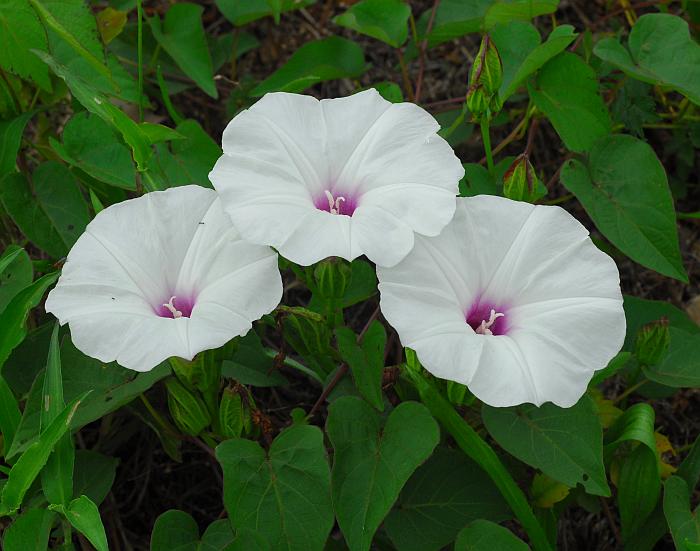Ipomoea pandurata (L.) G. Mey.
Wild Potato Vine

Native
CC = 2
CW = 3
MOC = 65
© SRTurner
Ipomoea pandurata (L.) G. Mey.Wild Potato Vine | |
 |
Native CC = 2 CW = 3 MOC = 65 |
© SRTurner |
|
Family - Convolvulaceae Habit - Perennial forb, with a somewhat woody rootstock and a large, deep-set tuberous portion of the main root. Stems - Vining, twining, to 5 m, branching or not, glabrous or sparsely and inconspicuously hairy. Root is large (to 50 cm long and weighing up to 30 pounds), vertical, and tuber-like. Leaves - Alternate, simple, long-petiolate. Petioles 9 cm, glabrous to pubescent, with a shallow adaxial groove. Blades 2-12 cm long, unlobed, broadly ovate or sometimes pear-shaped in outline, tapered to a sharply pointed tip, usually deeply cordate at the base, glabrous or the undersurface sparsely to moderately short-hairy, some of the hairs sometimes glandular, the margins entire.
Inflorescence - Solitary axillary flowers or pedunculate cymes of 2-10 flowers. Pedicels to 2 cm long, glabrous, bearing herbaceous bracts to 2 cm long. Flowers - Sepals dissimilar in size and shape, the outer sepals noticeably shorter and slightly narrower than the inner ones, 13-20 mm long, oblong-elliptic to less commonly oblong-ovate, rounded or very bluntly pointed at the tip, occasionally tapered abruptly to a short, sharp point or shallowly notched, glabrous or less commonly minutely hairy toward the margins. Corollas 5-8 cm long, funnelform to slightly bell-shaped, the tube widened gradually toward the tip, white with a reddish purple center. Stamens 5, unequal, adnate near base of corolla tube, not exserted. Filaments to 2 cm long, glabrous apically, pubescent and expanded slightly at base. Anthers whitish-pink, 8 mm long. Style glabrous, white, included. Ovary superior, green, conic, 1-2mm long, 2- or 4-locular, with 2 ovules. Placentation axile. Ovary with a green nectary at base. Stigma 2-lobed, 2-3 mm broad, becoming brown when dried.
Fruits - Ovoid capsules, the main body 10-16 mm long, the persistent style 0.5-35.0 mm long and frequently becoming irregularly curled, glabrous. Seeds 7-9 mm long, the surface densely pubescent with minute, matted hairs, the angles with a crest of dense, long hairs.
Flowering - May - September. Habitat - Streambanks, pond margins, fields, ditches, railroads, roadsides, open, disturbed areas. Origin - Native to the U.S. Lookalikes - Broadly, species of Calystegia. Other info. - This showy member of the morning glory family is found across most of Missouri, most commonly in the southern half of the state. It also occurs throughout the southeastern quadrant of the continental U.S. It is easily recognized by its vining habit, heart-shaped leaves, and large white flowers with wine-colored throats. It can be quite striking when in full flower. Steyermark recognized two forms within the state: form pandurata, having short hairs on either one or both leaf surfaces, and form leviuscula Fern., with glabrous leaves. Photographs taken in Brown Summit, NC., 8-1-02 (DETenaglia); also at Shaw Nature Reserve, Franklin County, MO, 7-14-2006 and 7-10-2021, Weldon Spring Conservation Area, St. Charles County, MO, 7-12-2010, near Pacific, St. Louis County, MO, 8-12-2012, Pacific Palisades Conservation Area, MO, 7-23-2020, and Allenton Access, St. Louis County, MO, 8-2-2020 (SRTurner); also in St. Louis, St. Louis County, MO, 12-11-2021 (KBildner). |